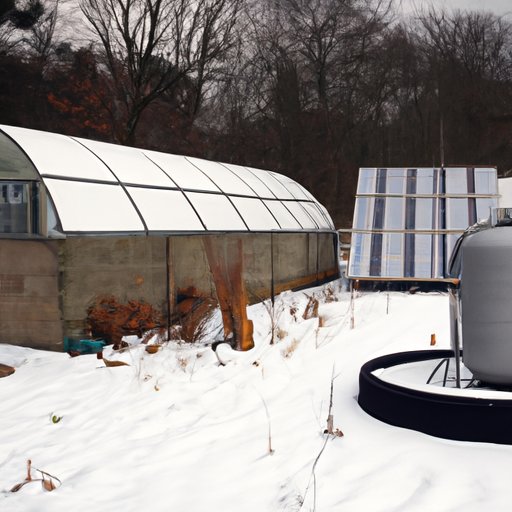
I. Introduction
Heating a greenhouse in the winter can be a difficult and expensive task. However, with some ingenuity and resourcefulness, it is possible to keep your plants warm and healthy without breaking the bank. Here, we will explore various methods of heating a greenhouse for free.
II. Passive Solar Heat
Passive solar heat is the process of using the sun’s rays to provide heat. In the winter months, this can be an effective way to keep your greenhouse warm. To make the most of the sun’s energy, it’s important to use the right type of windows and paneling. Insulated, double-pane windows are best for maximizing solar gain. Additionally, the orientation of your greenhouse can greatly affect its solar gain. Orienting your greenhouse towards the south can help it capture the most sunlight possible.
III. Composting
Composting generates heat, making it a useful method for heating a greenhouse. For this method to work, you will need enough compost to generate sufficient heat. Horse manure and chicken manure are the best options as they have high nitrogen levels. It’s important to create a layered compost pile and to monitor the temperature as it rises. Once the temperature reaches 130°F, you can begin circulating the hot air through pipes installed beneath the plants.
IV. Insulate the Greenhouse
Insulating a greenhouse is crucial in keeping the heat in. Bubble wrap, foam boards, and fiberglass are all effective materials for insulation. These materials can be added to the glass or plastic surfaces. It’s important to ensure that the insulation is air-tight. Sealing air leaks can prevent heat from escaping the greenhouse, thereby increasing the overall heat retention.
V. Water Barrels
A water barrel system is an interesting and cost-effective method of heating a greenhouse. Using large barrels, rainwater can be collected and stored inside the greenhouse. As the water thaws and freezes, it will give off heat, thereby warming the greenhouse. The barrels can be placed against the walls of the greenhouse and painted dark colors for maximum absorption of heat.
VI. Geothermal Heating
A geothermal heating system can be installed to heat your greenhouse. This involves a water loop which is installed beneath the ground where temperatures are more stable. The system works by circulating water through pipes, drawing heat from the ground, and transferring it to the greenhouse. The system can be powered through solar or wind energy. It is important to follow proper installation procedures, and to maintain and troubleshoot the system as necessary.
VII. Use Animal Waste
If you live on a farm, animal waste can be used to heat your greenhouse. Animal waste generates methane gas which can be captured and used to warm the greenhouse. The system works by installing a pipe system which captures the methane and circulates it through the greenhouse. Proper management of the system can prevent odors and pests.
VIII. Artificial Lighting
LED lights can be used to emit heat into your greenhouse. Installing LED lights in your greenhouse can provide the necessary heat to your plants. It’s important to avoid over-lighting the greenhouse and wasting energy. The lights should only be used when necessary and should be installed in a way that minimizes energy waste.
IX. Conclusion
Heating a greenhouse in the winter can be a costly and challenging task, but it doesn’t have to be. By using some of the above methods, you can keep your greenhouse warm and healthy, and do it for free. It’s important to find the best method that works for you and to experiment with different combinations. With some ingenuity and creativity, you can have a thriving greenhouse year-round.





